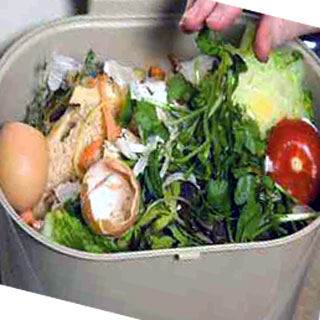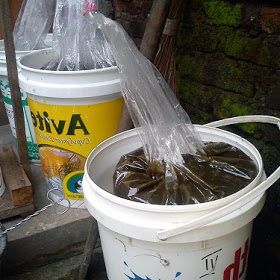Hay steemit, this is my first article @utramantaro and my second post in steemit. I will give tips for you who like gardening to make their own organic fertilizer at home by using household waste materials. So keep taking a comfortable sitting position to read my article so you can practice it at home.
Definition of Household Waste
Household waste in the scope of the manufacture of liquid organic fertilizer is household waste, especially organic materials derived from living things, plants that are not used anymore, unfit vegetables, marine animals that have been stale and others, other. Thus, for household waste such as crackle plastic, used bottles, sanitary napkins, and rotten wastes should be separated in separate containers and not included in the manufacture of liquid organic fertilizers.
As I mentioned before in the previous post, the way of making organic fertilizer from household waste is only for people who are not easily disgusted because the materials that we will use in the manufacture of liquid organic fertilizer is household waste that form and apparently not cool in the eyes. Not to mention the aroma that may be very disturbing. However if you do intend, this problem can disiasati by using masks and gloves.
Understanding Organic Fertilizer liquid
Organic fertilizers are fertilizers that are mostly or wholly composed of organic materials derived from plants or animals that have been through an engineering process, may be solid or liquid used to supply organic materials to condition or improve the physical, chemical, and biological properties of the soil. Liquid organic fertilizer is the resultant solution of decomposition of organic materials derived from crop residues and animal waste, with a compound nutrient content. The ingredients to make this are what distinguish organic and inorganic fertilizers. The result of composition test of nutrient content in inorganic fertilizers is usually more complete and measured compared to liquid organic fertilizer. However, although nutrient content in inorganic fertilizers is more complete than organic fertilizers, the negative impacts of inorganic fertilizer use are numerous.
Negative impact of inorganic fertilizer
- Causes water pollution.
- May lead to blue baby syndrome.
- Contamination of impurities.
- Causes dependence.
- Loss of micro element on soil.
- Burn (burn) due to excess fertilizer High energy consumption.
- Contributes to climate change.
- Impact on mycorrhiza.
- Eutrophication / increased rate of growth of aquatic plants.
- Increased soil acidity.
- Result air pollution.
Those are some of the disadvantages of using inorganic fertilizers. Conversely, for the use of liquid organic fertilizer has many benefits, among others:
Excess of Liquid Organic Fertilizer
- Generally does not cause the soil and plants to be damaged even though used as often as possible.
- Contains Giberelin or gibberellic acid (GA), the growth hormone stimulant plant to trigger the emergence of flowers and flowering simultaneously.
- Has a binder, so that the solution of fertilizer given to the soil surface can be directly used by plants.
- Alcohol content in organic fertilizer works for sterilization in plants, ie reducing and stopping the growth of disruptive microbes in plants, especially on leaves and stems, such as leaf spot, fungus and spores disease organism.
- Environmentally friendly, easy-to-get, and bag-friendly compared to the price of inorganic fertilizers that are increasingly expensive.
How to Make Organic Liquid Fertilizer from Household Waste
Well, we come to the discussion on how to make liquid organic fertilizer from household waste. Here are the steps:
- Prepare the raw materials, namely organic waste. You can get it from household waste or if you want to get plenty of raw materials you can look for vegetable remnants in the vegetable market.

- Then chop all green garbage like leftover vegetables, stale vegetables, and so on. Then prepare a plastic barrel or a used tray of 25 kilograms (kg) wall paint, complete with lid. Also prepare a plastic bag and give a few holes for 1 cm. This hole to facilitate the circulation of water in the barrel.

Prepare drops of sugar cane or dissolved sugar to activate EM4. Prepare EM4 to simplify the dissolution process. You can buy them at farm shops or make them yourself. If you want to create your own following guide.
Prepare the source water for maximum results do not use rain water or irrigation water because it can be polluted chemicals that can inhibit microbial growth. Mix the green garbage trash, EM4, and sugar water or sugar cane into the plastic barrel. After that the mixture is put into a plastic bag that has been perforated. Then put this plastic bag into the barrel and add it with ground water.

Do not forget to tie the plastic bag containing the green trash and seal the barrel for about three weeks.
After three weeks, open the lid and check the result. If the garbage in the barrel does not smell bad and looks shrunken it means making your liquid organic fertilizer successful. Lift the garbage in a plastic bag and drain. You will get 2 things, the garbage from the plastic into a solid fertilizer, while the water in the barrel into liquid organic fertilizer.
Thus the steps of making liquid organic fertilizer from household waste. It looks simple and easy right? Do not answer yes or no before you try it yourself. One thing is certain, all the above techniques and theories will not mean much to you if you never practice. Because theory is only a theory. The real science you will get through the experiences and the trial and error process.
Thank you for visiting and reading. If there are readers who have interesting experiences about how to make liquid organic fertilizer do not hesitate to share through the comment field below this post. I am sure it will be useful for me and other readers. Successful greeting to all.
Great topic. It seems similar to composting. But I like the idea of the plastic bag. That's really useful information. Thanks.
Downvoting a post can decrease pending rewards and make it less visible. Common reasons:
Submit
thank you for your positive response
Downvoting a post can decrease pending rewards and make it less visible. Common reasons:
Submit
Thank you for contributing your knowledge to help others! This post has been added to the Sotall.org Directory of Self Sufficiency & Survival posts. One of our goals is to provide access to the knowledge of our fellow Steamians, that will still be seen, long after the 7 day period is passed. If you write any future articles with instructions on how to do any tasks related to a homestead or survival, to ensure they are added to the directory, please submit them. They will be added as soon as possible.
Downvoting a post can decrease pending rewards and make it less visible. Common reasons:
Submit